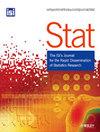利用受限平均存活时间对与存活结果非线性关联的高维特征进行筛选
IF 0.8
4区 数学
Q3 STATISTICS & PROBABILITY
引用次数: 0
摘要
摘要特征筛选是分析超高维数据的重要工具,尤其是在分子生物学和肿瘤学研究领域。然而,大多数注意力都集中在识别对响应变量有线性或单调影响的特征上。检测与响应变量具有非线性或非单调关系的稀疏变量集仍然是一项具有挑战性的任务。为了填补这一空白,本文提出了一种针对右删失生存数据的稳健无模型筛选方法,提供了一个量化协变量对受限平均生存时间影响的新视角,而不是常规使用的危险函数。所提出的测量方法基于协变量分层的受限平均生存时间与整体数据之间的差异,能够识别包括线性、非线性、非单调甚至局部依赖性(如变化点)在内的各种类型的关联。建立了确定的筛选属性,并开发了更灵活的迭代筛选程序,以提高变量筛选的准确性。通过模拟研究,证明了所提方法在筛选与响应变量有复杂关联的重要特征方面的优越性。模拟研究还探讨了应用所提方法处理间隔删失失效时间数据的潜力,结果令人鼓舞。该方法被应用于乳腺癌数据集,以确定潜在的预后因素,从而揭示乳腺癌和淋巴瘤之间的潜在关联。本文章由计算机程序翻译,如有差异,请以英文原文为准。
High‐dimensional feature screening for nonlinear associations with survival outcome using restricted mean survival time
SummaryFeature screening is an important tool in analysing ultrahigh‐dimensional data, particularly in the field of Omics and oncology studies. However, most attention has been focused on identifying features that have a linear or monotonic impact on the response variable. Detecting a sparse set of variables that have a nonlinear or nonmonotonic relationship with the response variable is still a challenging task. To fill the gap, this paper proposed a robust model‐free screening approach for right‐censored survival data by providing a new perspective of quantifying the covariate effect on the restricted mean survival time, rather than the routinely used hazard function. The proposed measure, based on the difference between the restricted mean survival time of covariate‐stratified and overall data, is able to identify comprehensive types of associations including linear, nonlinear, nonmonotone and even local dependencies like change points. The sure screening property is established, and a more flexible iterative screening procedure is developed to increase the accuracy of the variable screening. Simulation studies are carried out to demonstrate the superiority of the proposed method in selecting important features with a complex association with the response variable. The potential of applying the proposed method to handle interval‐censored failure time data has also been explored in simulations, and the results have been promising. The method is applied to a breast cancer dataset to identify potential prognostic factors, which reveals potential associations between breast cancer and lymphoma.
求助全文
通过发布文献求助,成功后即可免费获取论文全文。
去求助
来源期刊

Stat
Decision Sciences-Statistics, Probability and Uncertainty
CiteScore
1.10
自引率
0.00%
发文量
85
期刊介绍:
Stat is an innovative electronic journal for the rapid publication of novel and topical research results, publishing compact articles of the highest quality in all areas of statistical endeavour. Its purpose is to provide a means of rapid sharing of important new theoretical, methodological and applied research. Stat is a joint venture between the International Statistical Institute and Wiley-Blackwell.
Stat is characterised by:
• Speed - a high-quality review process that aims to reach a decision within 20 days of submission.
• Concision - a maximum article length of 10 pages of text, not including references.
• Supporting materials - inclusion of electronic supporting materials including graphs, video, software, data and images.
• Scope - addresses all areas of statistics and interdisciplinary areas.
Stat is a scientific journal for the international community of statisticians and researchers and practitioners in allied quantitative disciplines.
 求助内容:
求助内容: 应助结果提醒方式:
应助结果提醒方式:


